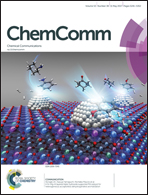Supramolecular chemistry of pillar[n]arenes functionalised by a copper(i)-catalysed alkyne–azide cycloaddition “click” reaction
Abstract
Since we discovered pillar[n]arenes in 2008, many chemists have developed a strong interest in pillar[n]arene chemistry because of the many advantages associated with these materials, including their facile and high yielding synthesis, versatile functionality, planar chirality and unique host–guest properties. In this feature article, we discuss recent advances in the field of supramolecular chemistry based on the use of pillar[n]arenes as substrates for copper(I)-catalysed alkyne–azide cycloaddition (CuAAC) “click” chemistry. The CuAAC reaction provides facile access to 1,4-disubstituted triazoles by a reaction between alkyne and azido substrates in the presence of a Cu(I) catalyst. Pillar[n]arenes bearing alkyne or azido groups can therefore be used as substrates for this reaction. Herein, we discuss not only the synthesis of pillar[n]arenes bearing alkyne or azido groups but also the application of these functionalised systems to the CuAAC reaction to construct supramolecular assemblies. We also discuss the rational molecular design and synthesis of guest compounds using the CuAAC reaction because linear alkanes sandwiched between 1,2,3-triazole moieties are good guests for cyclic pentamer pillar[5]arenes.
![Graphical abstract: Supramolecular chemistry of pillar[n]arenes functionalised by a copper(i)-catalysed alkyne–azide cycloaddition “click” reaction](/en/Image/Get?imageInfo.ImageType=GA&imageInfo.ImageIdentifier.ManuscriptID=C7CC01833A&imageInfo.ImageIdentifier.Year=2017)


 Please wait while we load your content...
Please wait while we load your content...